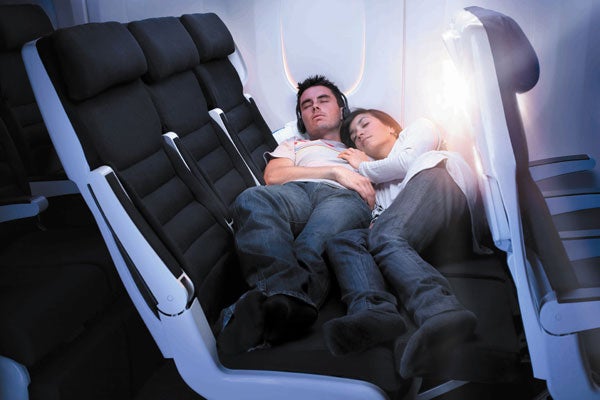Simon Calder: Lie back and think of Air New Zealand

First or last? In the context of boarding a flight, the right choice depends on the airline you are flying with. On a low-cost carrier with no advance seat selection, first is best: easyJet passengers pay up to £16 return for "Speedy Boarding" ahead of the pack. But on traditional airlines offering pre-assigned seats, being last to walk the airbridge has many virtues.
First, the less time you sit in a cramped airline seat, the better. Being the last one on board minimises that discomfort, though as you saunter smugly down the aisle you may be discomfited by glares from other passengers that say: "Are we waiting for you?"
Next, the later you board, the higher the chance you will discover that your seat is already occupied. In my experience, that can be an advantage: if the cabin crew need to upgrade someone in order to resolve the conflict, more often than not they choose the passenger who is standing. That, however, was not the case earlier this month, when I found seat 4H from Cairo to Heathrow had been double-booked. (To digress for a moment: I even recognised the man who shared the same seat allocation – though I had never seen him with his clothes on. He had been a guest at the Nile Hotel in the Egyptian capital; I hadn't, but I paid to use the pool on a couple of occasions and got chatting, since he was about the only other bather.) On this occasion, though, it was my fully dressed friend who was invited to the front of the plane.
Third, if you know you are the last to board (the ground staff may be yelling at you to that effect), then you are the first to know exactly where the empty seats are. If the travel gods are smiling, you may be able to claim a row of three all to yourself. On a long flight such as Heathrow to Hong Kong or Los Angeles to Auckland, this is worth a fortune.
Business travellers (or their companies) pay high fares for the privilege of a flat bed, but three seats together constitutes an almost-flat makeshift bed for the price of a discounted economy ticket. Great if you travel alone – but many people are less antisocial than I am, and prefer to fly with a companion. If you are in this category, then Air New Zealand has a seductive offer. Forget economy and business: welcome to "Cuddle Class".
Cuddle Class is not the actual name of the service that will soon take to the skies on the airline's latest Boeing 777 aircraft, but it describes the concept concisely. More than half a century after three-abreast seating became common thanks to the Boeing 707, Air New Zealand has come up with a simple piece of kit that effectively moves the footrests up to seat-cushion level, creating a surface the size of a slim single bed. As anyone who has suffered a long flight in economy class will understand, the layout confers a much greater sense of space.
Two become two and a half in terms of fares: the Skycouch, as it is officially known, will be sold to couples with a 25 per cent premium per person. So, if you can find an £800 return from London to Auckland per person, you would pay an extra £200 per person for extra space and privacy. No need to get territorial, either; you own the title to all three seats.
At around £4 per person per flying hour on top of the ordinary ticket, cuddle class has to be one of the best bargains in travel. I imagine Air New Zealand will soon find it can raise the premium. And good luck to the airline for coming up with something genuinely beneficial for the mass of travellers in economy class.
Snuggler's rest – but that's the limit at seven miles high
"The worst year the industry has ever seen" – that was how the airlines' trade association, IATA, summed up 2009 this week. Its director-general, Giovanni Bisignani, warned of "another spartan year" for the world's carriers.
Air New Zealand currently fills an average of four out of five seats: the Skycouch is a neat way to "monetise" space that would otherwise go empty. But the publicity picture shows the layout provides potential for activities other than sleeping.
"Certainly we won't do anything to encourage that," said Ed Sims, the Air New Zealand executive behind the concept.
British snugglers will be able enjoy this economical innovation on flights from Heathrow from April next year.
Join our commenting forum
Join thought-provoking conversations, follow other Independent readers and see their replies
Comments
Bookmark popover
Removed from bookmarks